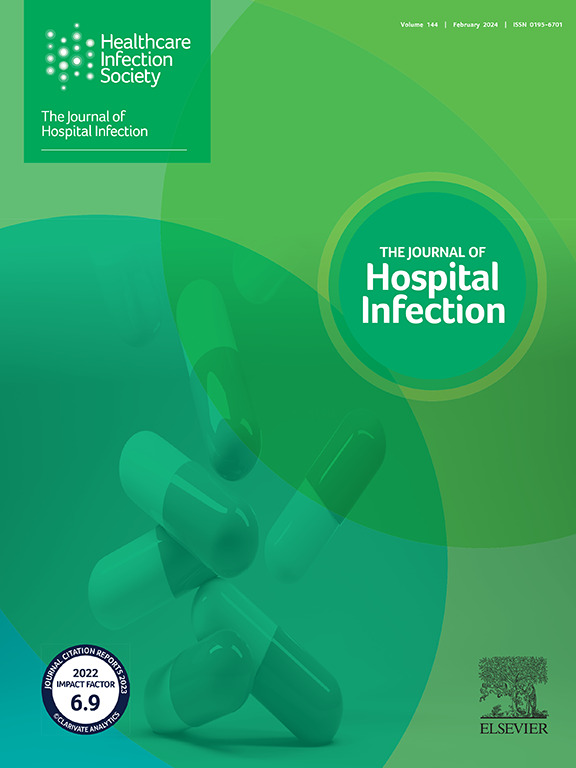不同压力对柔性内窥镜干燥时间的影响。
IF 3.9
3区 医学
Q1 INFECTIOUS DISEASES
引用次数: 0
摘要
背景:内窥镜的复杂结构导致干燥条件不均匀。然而,目前临床干燥实践缺乏精确的指导,导致一些内窥镜干燥不足,增加了感染的风险。压缩空气的压力已被证明会影响内窥镜干燥的有效性;但是,没有具体的要求。本研究探讨了不同压力条件下不同内窥镜充分干燥所需的时间。方法:选择6种常用奥林巴斯柔性内窥镜,每种内窥镜分别在0.102、0.204 MPa压力下设置多个干燥时间组,每组观察10只内窥镜。结果:干燥时间因种类和压力的不同而不同。在0.102 MPa下,仪器通道干燥时间为80 ~ 160 s(平均123 s),吸入通道干燥时间为260 ~ 540 s(平均428 s)。在0.204 MPa下,仪器通道干燥时间为50秒至90秒(平均72秒),吸入通道干燥时间为130秒至230秒(平均186秒)。结论:内窥镜的最佳干燥时间因类型和压力不同而不同。更高的压力(0.204 MPa)有效地去除水分,加速干燥。相同活检通道直径的更长的内窥镜需要更长的干燥时间。此外,仪器通道比吸入通道干燥得快。本文章由计算机程序翻译,如有差异,请以英文原文为准。
Impact of different pressures on the drying time of flexible endoscopes
Background
The complex structure of endoscopes causes non-uniform drying conditions. However, current clinical drying practices lack precise guidance, leading to the insufficient drying of some endoscopes, which increases the risk of infection. The pressure of compressed air has been shown to influence the effectiveness of endoscope drying; however, specific requirements are absent.
Aim
To determine the time required for the sufficient drying of different endoscopes under various pressure conditions.
Methods
Six different types of commonly used Olympus flexible endoscopes were selected, and for each type, multiple drying time groups were set under pressures of 0.102 and 0.204 MPa, with 10 endoscopes observed in each group.
Findings
Drying times varied according to the type and pressure. At 0.102 MPa, the instrument channel drying ranged from 80 s to 160 s (average: 123 s), while suction channel ranged from 260 s to 540 s (average: 428 s). At 0.204 MPa, the instrument channel dried in 50 s–90 s (average: 72 s), and suction channel in 130 s–230 s (average: 186 s).
Conclusion
Optimal drying times for endoscopes differ according to the type and pressure. A higher pressure (0.204 MPa) efficiently removes moisture and speeds up drying. Longer endoscopes with the same biopsy channel diameter require longer drying time. In addition, the instrument channel dries faster than the suction channel.
求助全文
通过发布文献求助,成功后即可免费获取论文全文。
去求助
来源期刊

Journal of Hospital Infection
医学-传染病学
CiteScore
12.70
自引率
5.80%
发文量
271
审稿时长
19 days
期刊介绍:
The Journal of Hospital Infection is the editorially independent scientific publication of the Healthcare Infection Society. The aim of the Journal is to publish high quality research and information relating to infection prevention and control that is relevant to an international audience.
The Journal welcomes submissions that relate to all aspects of infection prevention and control in healthcare settings. This includes submissions that:
provide new insight into the epidemiology, surveillance, or prevention and control of healthcare-associated infections and antimicrobial resistance in healthcare settings;
provide new insight into cleaning, disinfection and decontamination;
provide new insight into the design of healthcare premises;
describe novel aspects of outbreaks of infection;
throw light on techniques for effective antimicrobial stewardship;
describe novel techniques (laboratory-based or point of care) for the detection of infection or antimicrobial resistance in the healthcare setting, particularly if these can be used to facilitate infection prevention and control;
improve understanding of the motivations of safe healthcare behaviour, or describe techniques for achieving behavioural and cultural change;
improve understanding of the use of IT systems in infection surveillance and prevention and control.
 求助内容:
求助内容: 应助结果提醒方式:
应助结果提醒方式:


